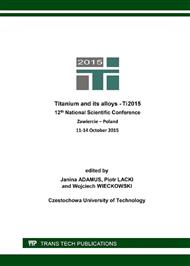p.98
p.106
p.111
p.117
p.125
p.133
p.141
p.149
p.155
Cross-Wedge Rolling of Driving Shaft from Titanium Alloy Ti6Al4V
Abstract:
This paper deals with the issue of the helicopter SW4 rear gear driving shaft forming. It was assumed that this shaft will be made from titanium alloy Ti6Al4V and it will be formed by means of cross-wedge rolling technology (CWR). It was also assumed that rolling will be realized in double configuration, which will guarantee axial symmetry of forming forces. The conception of tools guaranteeing the CWR process realization and numerical analysis results verifying the assumed CWR process parameters of the subject shaft were presented. Tests of shaft rolling in laboratory conditions at Lublin University of Technology were made, in the result of which the possibility of forming by means of CWR of a driving shaft, manufactured from titanium alloy Ti6Al4V, of the helicopter SW4 rear gear was verified.
Info:
Periodical:
Pages:
125-132
Citation:
Online since:
April 2016
Authors:
Price:
Сopyright:
© 2016 Trans Tech Publications Ltd. All Rights Reserved
Share:
Citation:


